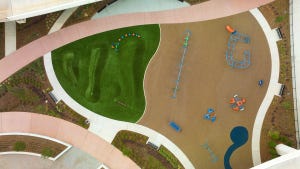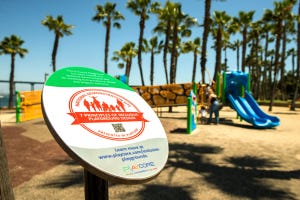'Til Play Do Us Part
This is the fourth post in the six-part Playground Planning 101 series. Here are links to part one, part two, and part three.
Choosing a vendor to partner with is a lot like picking a wedding planner. You want to choose someone with experience who understands your needs, sees your vision, and knows the best way to execute it. If you’re not sure how to start, you can look at the International Playground Equipment Manufacturer’s Association (IPEMA) Companies with Certified Products website to see which companies are available and that their products meet relevant safety standards. It’s like a background check for your equipment and vendor. Also, ask around. Don’t settle for the first company you speak with (unless it’s us, we will love you forever). Consult several different companies and discuss their areas of expertise. Each consultant may bring different strengths to the table, and it’s good to gauge who may best be able to provide what you need based on things like the size of the playground site, the number of children to be accommodated, any other design requests you wish to incorporate, and who you "just click" with.
What questions should you ask when looking at playground vendors? It may not be as efficient as speed-dating but here are some topics and questions that you should consider:
Experience:
- How long has the playground manufacturer been in business?
- Does the playground company have experience designing to meet ADA guidelines? What about universal or inclusive design?
- What experience do they have in designing to promote a continuum of skill development?
- Are their installers factory trained and certified in playground installation?
- How many success do they have with leading volunteers in a community build?
Products:
- Do their products meet or exceed applicable standards?
- Are their products certified by the International Equipment Manufacturers Association (IPEMA)?
- What is their warranty on equipment?
- Do they carry product liability insurance? How much is the policy?
- What is the response time for designs/proposals?
- How are their play systems installed? Are they volunteer-build friendly?
Budget:
- Are there charges for providing community build tools?
- Is there a fee for supervising a community build?
- Will they provide a line item invoice so you know what you are paying for equipment vs. other services, like installation?
- Do they charge for design services?
- Is there a separate charge for images, top views, and renderings of the play space design?
Service:
- Will they conduct a thorough and collaborative analysis to determine your needs and priorities?
- Can they provide local references and addresses of playgrounds for review?
- Will they assist you with engaging community stakeholders and funders?
- Can they recommend how many volunteers you will need to install the equipment, if you are choosing a community build?
- Do they have the capability to perform a site assessment, site work, and/or remove old equipment?
Resources:
- Do they offer research-based resources for designing inclusive playgrounds?
- Do they offer research-based programs for physical education on the playground?
- Do they offer research-based program resources for designing around nature?
- Do they offer grant sources and grant writing guides?
- What type of maintenance guides/recommendations will they provide?
- What kind of supervision guidebooks/recommendations will they provide?
Know the Roles
Since we are on this wedding theme (is love in the air?), the next thing to determine is the bridal party - you’ll want to be sure you have the right best man and maid of honor picked out. Your vendor should be able to help you determine what is expected of a few key roles. And some of these roles may be played by the same person:
- Lead Project Manager: This person will be the main contact for your project and in charge of design, purchasing, scheduling, and pricing.
- Designer: This person will be responsible for looking at your budget and site dimensions and translating those into a playground design that meets your needs and requirements.
- Local Project Manager: This person will be in charge of scheduling, supervising information, organization, and delegation of responsibilities to your volunteers.
- Customer Service Rep: This person will be responsible for having a thorough knowledge of your project and help you contact your fellow vendor team members while also answering any questions you may have about the product, warranty claims, and more.
- Accounting Manager: This person is your contact for insurance, billing, and accounting questions.
- Professional Supervisor: This person will have professional certification in playground installation from the company they represent and be onsite to make sure volunteers follow instructions and ensure compliance of your playground to protocol.
What Type of Build?
The next thing you should consider is if you want this playground professionally installed or a supervised volunteer-based building effort. There will be plenty of jobs for willing volunteers, whether you install the playground yourself, or have it professionally installed for you. If you choose to have a supervised community build, one or more professionally trained installers recommended by the playground manufacturer will come to your site to tell your volunteers what to do, ranging from locating and digging holes to spreading surfacing. Another option is to use more of the manufacturer’s factory-trained certified installers, who can be contracted to assist in pre-construction planning and in the actual installation of the playground equipment. They can come before construction day to look at your job site and/or remain there to help with the installation. This would be useful because it would ensure that your playground was being installed according to specifications. You may also decide to have it fully installed by professionals. This is a great option if you prefer your volunteers to help with tasks like landscaping or spreading wood fiber surfacing.
A supervised community build is more budget-friendly and helps stakeholders develop a sense of ownership in the project. A turnkey installation by certified installers is more expensive, but can be more efficient and effective if you don't have a good source of volunteers.
Let’s face it, you’re essentially going to be married to your playground vendor for a few months so you want to be sure that you choose wisely. You’re going to want someone who understands your specific needs (you’re not like just every other catch in the sea) and who understands what type of labor will be required to get the job done in a cost efficient, timely, and highly professional manner.
What's Next?
In our next post, we will discuss what it takes to organize a successful event. If you are on the edge of your seat and can’t wait, request a copy of Blueprint for Play and get all the details now. Or contact us and let us help you tell your playground story!





